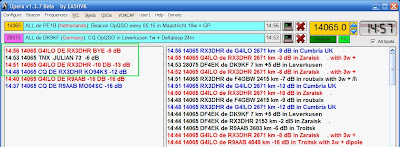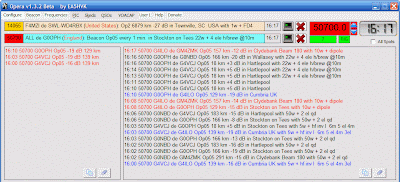Posts Tagged ‘OPERA’
 First HF Opera QSO
First HF Opera QSO
Yes. Opera now has a QSO mode. I had to update KComm to allow the Opera contact to be logged, so I thought I’d add ROS for good measure. You never know. 🙂
eQSL still won’t accept the mode “Opera” as it hasn’t yet been added to the ADIF specification. It remains to be seen whether the mode catches on. It’s an obvious rival to JT65A but the JT mode has a lot more users. Opera is not time-synchronous and allows a bit more free-text flexibility.
By the way, have any of you Blogger users noticed that you can’t insert GIF images into blog posts any more? When I try, I just get an empty box. I have to save all my images as JPG which is not a very efficient format for screenshots.
 Opera on 6
Opera on 6
I haven’t used the Opera digital mode on HF for a bit as it seemed that interest had dropped off and there is not much point in beaconing in no-one is receiving. It seems to be one of those modes where there is a resurgence of interest whenever there is something new to try. This weekend the new thing was some fast Opera modes for use on VHF so I fired up the K3 on 6m (50.700MHz) to see if I could receive anything.
As you can see, not only did I receive some other stations but my own Opera signals were received around the UK. No great DX, but I was only using 20W to my attic dipole and would not expect to hear anything on 6m at this time.
If enough people were prepared to use it, this could be a good tool for discovering Sporadic-E openings on the VHF bands. The 30 second transmit cycle seems more appropriate for this type of propagation than WSPR’s two minute periods.
 Who broke it this time?
Who broke it this time?
I have just finished the heavy dose of chemo for my fourth cycle so for the last week and for several more days it will be more than usually difficult to concentrate or even get motivated to do anything. Mostly over the last week I have just been tinkering with the Parallax Propeller WSPR and Opera beacon code and running the beacon barefoot on the air.
Stupidity seems to dog my programming efforts as much as my attempts at electronics construction. I wasted a couple of hours trying to understand why the Propeller was not doing what I wanted before eventually realizing that it was doing exactly what I had told it. I was nearly at the point of splashing out on ViewPort, an interactive debugger for Spin code that would allow me to step through my programs a line at a time. That would quickly have revealed the error, but it would have been a high price to pay to show me what was staring me in the face.
I had been pleasantly surprised at the reach of my barefoot 20mW Propeller beacon, receiving a number of reports of both Opera and WSPR signals. Today I modified my beacon program to transmit both a WSPR and then an Opera beacon, but frustratingly I have not received a single report of either of them on 30 metres. Have I broken the program again or did someone break the ionosphere? I really need to get motivated enough to build a small PA and boost the signal to at least the hundred milliwatt level.
 Propeller takes to the air
Propeller takes to the air
Today I have been playing around with MEPT beacon code on my Gadget Gangster Parallax Propeller board. First I wandered over to Jeff, KO7M’s blog and borrowed his WSPR beacon code.
| Gadget Gangster in use as a 25mW WSPR/Opera beacon |
WSPR was the thing I originally wanted to try when I decided to get the Gadget Gangster: I hadn’t even heard of OPERA at that time. But I was unsure whether I would be able to generate the FSK frequencies WSPR uses: four tones separated by about 1.48Hz. Jeff decided to shoot as near as he could and programmed for a 2Hz separation of tones, and found that the signal was decoded by K1JT’s WSPR program. So no problem!
I measured the RF output from the Propeller board and it was somewhere in the region of 25 to 40mW, depending on which measurement method you believe. I also looked at the output using my oscilloscope.
 |
| Output waveform from Parallax Propeller on 80m |
It wasn’t a pure sine wave, there’s obviously some harmonic content there, but it was not as bad as I feared it might be. As I would be using my MFJ magnetic loop on 30m, which has a very narrow bandwidth, I decided not to bother with a low pass filter for the sake of these initial trials. I watched the seconds tick over on my shack radio-controlled clock, started the beacon and was soon rewarded by several WSPR spots!
 |
| WSPR spots for 25mW Propeller beacon |
Because WSPR is a time-synchronous mode I had to start the beacon when the seconds ticked over to 00. This brought to light a problem Jeff had already observed: the Propeller drifts. The drift seems to be worst during the first few minutes of operation, so leaving the beacon running so it can reach a stable temperature would appear to be the solution. However that is not so easy when you have to power it on at an exact time. I will need to look in to implementing a real-time clock for WSPR, unless I want to interface a GPS receiver to the Propeller – which is certainly possible and something else I hope to try as I’d like to have a go at making an APRS tracker.
An advantage of the OPERA mode is that it is not time synchronous so I can leave the beacon running in that mode with an arbitrary delay between transmissions. My first OPERA transmission also produced several spots, including reports from fellow bloggers PC4T and G4NKX.
 |
| OPERA spots for 25mW Propeller beacon |
I can also generate Morse and QRSS beacons using the Propeller chip. There is still a lot to do to reach my goal of a multimode, frequency-agile beacon, including adding a PA and some switchable bandpass filters. But so far this project has turned out to be easier than I thought it would.
 Propeller does WSPR
Propeller does WSPR
Through Eldon, WA0UWH I have discovered another blog to add to the blogroll: that of Jeff, KO7M. Jeff is interested in a lot of the same things I have been (including light aviation: an ambition of mine when I was in my 20s but which I could never afford to take up.) But what really piqued my interest was that he has just got a Parallax Propeller to generate a WSPR signal.
This is one of the things I was interested in trying. But I never got further than wondering how to implement the fractional frequency shifts of the WSPR signal, which uses 4 tones shifted by just under 1.5Hz from each other. Jeff has apparently found that a 2Hz shift is good enough to be decoded, allowing WSPR to be sent using the integer frequencies the Propeller chip can easily generate.
Once I have finished the Tiny Keyer project and can get back to the Propeller I will be trying this myself. My ambition at the moment is to make a multi-band multi-mode (OPERA, WSPR and perhaps QRSS as well) standalone beacon with an LCD panel to enable me to choose the band and mode. We’ll see how far I get, but having two other people working on the same ideas should certainly make the task easier!
 More Operatics
More Operatics
Paul PC4T may be taking a rest from blogging but he is still active. Yesterday evening I spotted him using the new Opera mode.
Andy K3UK has prepared a quick guide to using Opera which some may find helpful. As he points out, Opera is not a QSO mode. The only information that is sent in a beacon transmission is your callsign. Other information that is displayed in the software such as QTH, distance and bearing is sent over the internet back-channel by connected software clients.
Eldon WA0UWH has taken the Parallax Propeller code from my previous post and tried it out on the air. He has already received several reception reports.
Before I can do the same I will need to build a small PA / LPF with an output in the range 200mW to 500mW. Hopefully I can find a suitable circuit that uses standard components such as 2N3904 or 2N2222 which I have in my parts box. Suggestions welcome.
 Operatic triumph
Operatic triumph
A new version of the Opera software has just been released which can output the bit code of a beacon signal so it can be programmed into a microcontroller such as a PIC or a Parallax Propeller chip. (You can find the download via the Links page of the Opera Yahoo group.)
I modified Eldon Brown WA0UWH’s QRSS program code to send the bit code generated by the Opera software and it was received by my K3 on 30m and successfully decoded. Not bad for 5 minutes’ work! You can download the code here.
Just as Eldon did I will have to build an amplifier to raise the output of the Propeller from a couple of milliwatts to something with a better chance of being received. Before it is worth doing that people will have to start using the Opera mode on the HF bands because with my antenna restrictions I have no hope of receiving or radiating a signal on LF or VLF. But I am quite excited at the possibility of building simple standalone beacon transmitters for this new weak signal mode which is much easier to generate than WSPR or QRSS.
Stop press: Just decoded G0NBD on 10.135MHz +1500Hz for my first real over-the-air Opera spot. And it appears my first transmission (using the PC software and my K3 at 5W) has been received by OM5NA at -21dB. This is fun!














